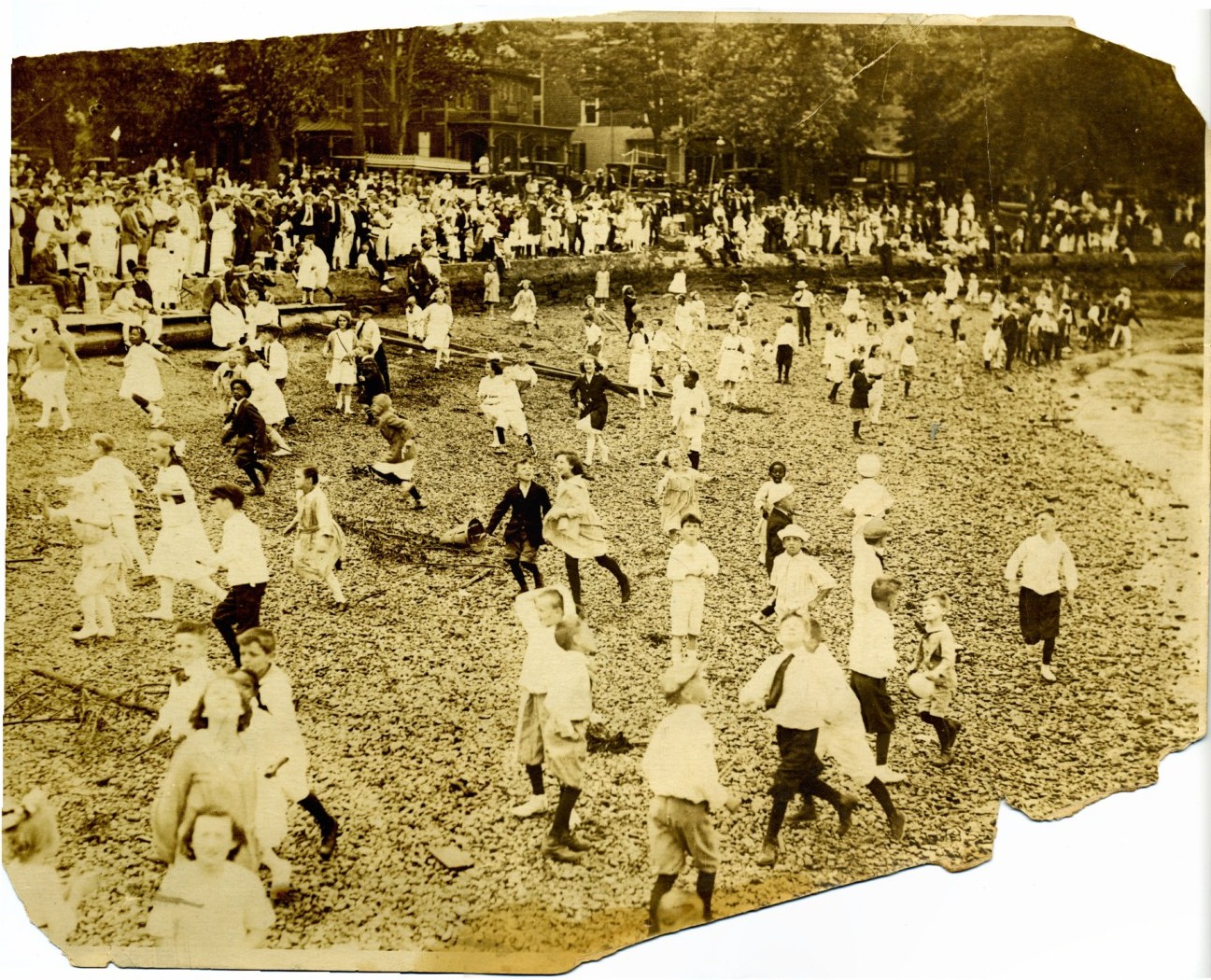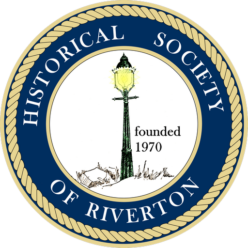![New Leaf ready for the 4th [1600x1064]](https://rivertonhistory.com/wp-content/uploads/2011/07/New-Leaf-ready-for-the-4th-1600x1064-300x199.jpg)
Former Rivertonians from near and far return for the event to re-connect with family and friends. The grand parade includes homemade floats, a Pet Pageant, kids with decorated bikes and wagons, classic autos, marching bands, musical groups, and military units. Throughout the town homeowners proudly display American flags and patriotic bunting. A parade route lined with hundreds of exuberant spectators attired in patriotic dress completes this Norman Rockwellian masterpiece. But Riverton’s Fourth of July observances were not always so spectacular.
The approaching festivities are all the excuse this former Riverton School history teacher needs to examine the beginnings of what the 1892 New Jersey Mirror was calling over 100 years ago “Riverton’s Glorious Fourth.”
I again defer to the research of our Town Historian, Mrs. Betty B. Hahle, who recently passed away after devoting many years to discovering and preserving Riverton’s past. From the May 1981 Gaslight News comes the origin story of this 114th Riverton Fourth of July Children’s Parade. As she wished, the excerpts below are copied as she wrote them:
“… July’s celebration in the growing village of Riverton was soon being called ‘Riverton’s Glorious Fourth’. In 1892 newspaper reports said ‘the quiet Quaker town put on holiday attire…’ and described the yachts and all smaller boats decked out with flags of all nations, and the competition among home owners in decorating their homes. That year the 28th annual Regatta at the Yacht Club was held. Celebrations focused on the children’s flag parade and on athletic events as well. … Wheelmen’s Clubs were formed, and meets became a part of the growing interest in athletic events. Riverton’s team used a track on Fulton street, below the railroad, and then a larger one above the railroad, where Lippincott, Thomas, and 7th streets are today. June of 1894 saw the new track completed there, in time for the riders to begin training for the big meet on July 4th.”

Betty’s “Yesterday” column in the May 1986 Gaslight News reveals another chapter in the holiday’s development:
“And Summer soon follows…wooden tubs of Crane’s ice cream, packed in chunks of ice and delivered by steamer from Philadelphia to the Riverton pier. And then…the Fourth of July!

In 1886 Riverton celebrated the Fourth ‘in the old fashioned way, with houses decorated with bunting and flags…and lighted with Chinese Lanterns’. The Chinese Lanterns at the Lynch home, 2nd & Main, merited special note. Races at the Yacht Club had to be called off because of lack of wind, so pair-cared scull races ware substituted. Winners were Lawrence and Haines Lippincott. The Lawn House had some activities, and then the Calico Club paraded around town.
It was in 1897 that Charles W. Davis and Albert Briggs had the idea of a children’s parade for the celebration, and the Yacht Club liked the idea and set it in motion. The parade formed at the Roberts store on the point, each child was presented with a silk flag, and all preceded to the riverbank, where singing and oration followed. Aquatic events and then fireworks ended the day.
![Roberts_Store [1521x1200]](https://rivertonhistory.com/wp-content/uploads/2011/07/Roberts_Store-1521x1200-300x236.jpg)
The next year more than 250 children were in the parade, headed by the Metropolitan Band of Burlington. An article describing the day said that two 3-year-olds, Georgie Corner, dressed as Uncle Sam, and Clarice Frishmuth, as Goddess of Liberty, led the whole procession. Then there were 30 little boys, dressed in Dewey suits (the Spanish fleet had just been destroyed) and commanded by Captain Walter Wright, who had been drilling them for 2 weeks. Then came the 250 children with their silk flags, ‘prettily costumed’. At the riverbank, Rev. Charles Kevin, son-in-law of the 1st mayor of Riverton, gave an inspiring address. And evening fireworks climaxed the day.
In 1908 there was threatening weather–but some 600 children marched in the parade, led by Mayor Brown and Chief of Police Major, and the Metropolitan Band. 1932’s parade had a special feature: two of the marching Riverton Firemen wore fire hats that had been donated by L. A. Flanagan. They had been worn ca. 1842 by members of his family in Philadelphia, and bore the date of 1800, the year of their Fire Company’s founding.
![The Grove, Palmyra, NJ 1938 [800x600]](https://rivertonhistory.com/wp-content/uploads/2011/07/The-Grove-Palmyra-NJ-1938-800x600-300x189.jpg)
By the 1940’s and ’50’s the children’s athletic events in the Park took up most of the afternoon, with relays, sack, potato, 3-legged, and other races for various age groups, and prizes of skates, cameras, rings, and other things donated by local merchants. And free refreshments for all the children (from Riverton). Palmyra had its children’s events in the Grove, and often included a Punch-and-Judy show, then joined Riverton for fireworks on the riverbank.
Time brought some changes, but ‘Riverton’s Glorious Fourth’ became a well-established tradition, a day of shared activities, family gatherings, reunions with former residents and friends. In 1964 wooden wash-tub races and tilting were scheduled again, for the first time in some years. Floats were popular: some were individual, some were group entries; all showed imagination, enthusiasm, and many, many hours of work. The Porch Club, in 1965, had a large platform truck made to look like a front porch, with ladies in costume and seated in rocking chairs depicting a meeting in 1890. John Parker had made a large float of the Yacht Club; Frank Lockhart and Charles Foster made a large replica of Barnegat Lighthouse; and the Parry family celebrated the New Era’s 75th year of publication with scenes of their office as it was in 1890.
For a few years there were no fireworks to climax our Fourth of July celebrations, although other traditional activities continued. They were welcomed back enthusiastically recently, at the Park instead of the Riverbank—and once again the Fourth ended spectacularly.”
Riverton has a long history of honoring men and women who have served in the armed forces as this August 1983 installment of “Yesterday” reports:
![WWI signet ring top [768x768]](https://rivertonhistory.com/wp-content/uploads/2011/07/WWI-signet-ring-top-768x768-150x150.jpg)
“Memorial Park was dedicated on July 4, 1931. It had been a long while coming…after WW I an athletic field was decided upon, as a fitting memorial to those who had given their lives in service to our country, and to those who had returned. After many delays, a part of the Dreer property above the railroad was purchased from the company, and the Park was realized. Killam Bennett was Mayor when the land was purchased, and Howard Rogers was Mayor at its dedication. A decade prior to this 100 men and women who were veterans from Riverton were presented with rings, chosen by a Citizens’ Committee headed by Edward Flagg jr. Their names were published in the New Era. (Anyone have, or know of, one of these rings today?)”

This series of Betty Hahle’s “Yesterday” columns from past issues of the Gaslight News concludes with this anecdote from February 1982 and a most endearing photograph loaned by Mrs. Elsie Waters.
“A shield-shaped card in red, white, and blue from a 1920* Riverton Fourth, and a photo graph showing children scrambling for the cards along the riverbank turned thoughts to warmer weather. The cards were dropped from a low-flying plane, and entitled the bearer to a 1¢ purchase at the stores of Theodore Schneider, John Adolph, or D.D. Bastion.”

Certainly, today’s events are the ones that historians will study tomorrow. Help document the next chapter in this chronicle by adding your “Glorious Fourth” recollection from the past or present to this archive. You can find us on Facebook, too. Remember, folks, these are the good ol’ days. – John McCormick, Gaslight News editor
* Betty’s article states “1920” for the airplane story and Elsie’s paper token shows “1921.” I do not know for how many years the tokens were dropped.
P.S. For any Rivertonians who could not make it back for the parade this year, here is a link to the official site for the Riverton Fourth of July Committee so you can see all of the awesome activities that those dedicated volunteers have come up with for this year’s “Glorious Fourth.” You can download the PDF file of the 2011 program if you wish.

Riverton’s Fourth of July was a major event as I, my brother and sister grew up on Lippincott Ave. We marched or rode bicycles or in dog-pulled wagons during all of our childhood years. As a drummer in the PHS band it was a thrill to march down Broad Street anticipating all the events afterward. Wish I could be there to see it all again.
Many wonderful 4th’s at 406 Howard St. My cousins from Phila. would come and we had wonderful times. Still have the silk flags given to us when we marched in the parade. Special town to grow up in. Alice Cook Costello.